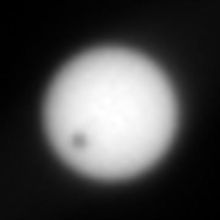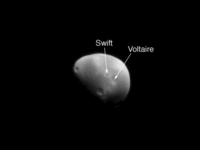- Deimos (moon)
-
Deimos  Discovery
DiscoveryDiscovered by Asaph Hall Discovery date 12 August 1877 DesignationsAdjective Deimosian Semi-major axis 23,460 kilometres (14,580 mi) Eccentricity 0.000 2 Orbital period 1.262 44 d (30.30 hours) Average orbital speed 1.35 km/s Inclination 0.93° (to Mars' equator)
1.793° (to the local Laplace plane)
27.58° (to the ecliptic)Satellite of Mars Physical characteristicsDimensions 15 × 12.2 × 10.4 km[2] Mean radius 6.2 kilometres (3.9 mi) [3] Mass 1.48×1015 kg[4]
(0.25 nEarths)Mean density 1.471 g/cm³[3] Equatorial surface gravity 0.003 9 m/s² (3.9 mm/s²)
0.000 40 g (400 µg)Escape velocity 5.6 m/s (20 km/h)[4] Rotation period synchronous Albedo 0.068[3] Temperature ≈233 K Apparent magnitude 12.4 [3][5] Deimos (
 /ˈdaɪməs/ dy-məs; also /ˈdiːməs/ dee-məs; Greek: Δείμος) is the smaller and outer of Mars's two moons (the other being Phobos). It is named after Deimos, a figure representing dread in Greek Mythology.[6] Its systematic designation is Mars II.[6]
/ˈdaɪməs/ dy-məs; also /ˈdiːməs/ dee-məs; Greek: Δείμος) is the smaller and outer of Mars's two moons (the other being Phobos). It is named after Deimos, a figure representing dread in Greek Mythology.[6] Its systematic designation is Mars II.[6]Contents
Discovery
Deimos was discovered by Asaph Hall, Sr. at the US Naval Observatory in Washington, D.C on August 12, 1877, at about 07:48 UTC (given in contemporary sources as "August 11 14:40" Washington mean time, using an astronomical convention of beginning a day at noon, so 12 hours must be added to get the actual local mean time).[7][8][9][10] Hall also discovered Phobos on August 18, 1877, at about 09:14 GMT, after deliberately searching for Martian moons.
The names, at first spelled Phobus and Deimus, were suggested by Henry Madan (1838–1901),[6] Science Master of Eton, from Book XV of the Iliad, where Ares (the Roman god Mars) summons Dread (Deimos) and Fear (Phobos).[11]
Characteristics
Physical
Deimos, like Mars' other moon Phobos, has spectra, albedos and densities similar to those of a C- or D-type asteroid. Like most bodies of its size, Deimos is highly non-spherical with dimensions of 15 × 12.2 × 10.4 km. Deimos is composed of rock rich in carbonaceous material, much like C-type asteroids and carbonaceous chondrite meteorites. It is cratered, but the surface is noticeably smoother than that of Phobos, caused by the partial filling of craters with regolith. The regolith is highly porous and has a radar estimated density of only 1.1 g/cm³.[13] The two largest craters, Swift and Voltaire, each measure about 3 kilometres across.
Orbital
Deimos' orbit is nearly circular and is close to Mars' equatorial plane. Mars' outer moon is possibly an asteroid that was perturbed by Jupiter into an orbit that allowed it to be captured by Mars, though this hypothesis is still controversial and disputed.[14] Both Deimos and Phobos have very circular orbits which lie almost exactly in Mars' equatorial plane, and hence a capture origin requires a mechanism for circularizing the initially highly eccentric orbit, and adjusting its inclination into the equatorial plane, most likely by a combination of atmospheric drag and tidal forces,[15] although it is not clear that sufficient time is available for this to occur for Deimos.[14]
As seen from the surface of Deimos, Mars would appear 1,000 times larger and 400 times brighter than the full Moon as seen from Earth, taking up one-eleventh of the width of a celestial hemisphere.[citation needed]
As seen from Mars, Deimos would have an angular diameter of no more than 2.5 minutes (sixty minutes make one degree) and would therefore appear almost star-like to the naked eye.[16] At its brightest ("full moon") it would be about as bright as Venus is from Earth; at the first- or third-quarter phase it would be about as bright as Vega. With a small telescope, a Martian observer could see Deimos' phases, which take 1.2648 days (Deimos' synodic period) to run their course.[16]
Unlike Phobos, which orbits so fast that it actually rises in the west and sets in the east, Deimos rises in the east and sets in the west. However, the Sun-synodic orbital period of Deimos of about 30.4 hours exceeds the Martian solar day ("sol") of about 24.7 hours by such a small amount that 2.7 days elapse between its rising and setting for an equatorial observer.

Because Deimos’ orbit is relatively close to Mars and has only a very small inclination to Mars’ equator, it cannot be seen from Martian latitudes greater than 82.7°.
Solar transits
Deimos regularly passes in front of the Sun as seen from Mars. It is too small to cause a total eclipse, appearing only as a small black dot traveling across the Sun. Its angular diameter is only about 2.5 times the angular diameter of Venus during a transit of Venus from Earth. On March 4, 2004 a transit of Deimos was photographed by Mars Rover Opportunity, and on March 13, 2004 a transit was photographed by Mars Rover Spirit.
Origin
The origin of the Martian moons is still controversial.[14] The main hypotheses are that they formed either by capture or by accretion. Because of the similarity to the composition of C- or D-type asteroids, one hypothesis is that the moons may be objects captured into Martian orbit from the asteroid belt, with orbits that have been circularized either by atmospheric drag or tidal forces,[15] as capture requires dissipation of energy. The current Mars atmosphere is too thin to capture a Phobos-sized object by atmospheric braking.[14] Geoffrey Landis has pointed out that the capture could have occurred if the original body was a binary asteroid that separated due to tidal forces.[17] The main alternative hypothesis is that the moons accreted in the present position. Another hypothesis is that Mars was once surrounded by many Phobos- and Deimos-sized bodies, perhaps ejected into orbit around it by a collision with a planetesimal.[18][19]
Named geological features
Only two geological features on Deimos have been given names. The craters Swift and Voltaire are named after writers who speculated on the existence of Martian moons before they were discovered.[20]
Crater Named after Coordinates Diameter (m) Swift Jonathan Swift 12°30′N 358°12′W / 12.5°N 358.2°W 1000 Voltaire Voltaire 22°00′N 3°30′W / 22°N 3.5°W 1900[21] Namesakes
USS Deimos (AK-78) was a United States Navy Crater class cargo ship named after the moon.
See also
References
- ^ Jacobson, R.A. and Rush, B. (2006) MAR063 (2007-06-28). "Planetary Satellite Mean Orbital Parameters". JPL/NASA. http://ssd.jpl.nasa.gov/?sat_elem. Retrieved 2008-02-13.
- ^ "Mars: Moons: Deimos". NASA Solar System Exploration. 2003-09-30. http://solarsystem.nasa.gov/planets/profile.cfm?Object=Mar_Deimos. Retrieved 2008-08-18.
- ^ a b c d "Planetary Satellite Physical Parameters". JPL (Solar System Dynamics). 2006-07-13. http://ssd.jpl.nasa.gov/?sat_phys_par. Retrieved 2008-01-29.
- ^ a b use a spherical radius of 6.23 km; volume of a sphere * density of 1.471 g/cm³ yields a mass (m=d*v) of 1.48e15 kg and an escape velocity (sqrt((2*g*m)/r)) of 5.6 m/s (20 km/h
- ^ "Classic Satellites of the Solar System". Observatorio ARVAL. http://www.oarval.org/ClasSaten.htm. Retrieved 2007-09-28.
- ^ a b c Blunck, Jürgen (2009). "The Satellites of Mars; Discovering and Naming the Satellites". Solar System Moons: Discovery and Mythology. Springer. p. 5. ISBN 3540688528, 9783540688525.
- ^ Hall, A.; Observations of the Satellites of Mars, Astronomische Nachrichten, Vol. 91, No. 2161 (October 17, 1877, signed September 21, 1877) pp. 11/12–13/14
- ^ Morley, T. A.; A Catalogue of Ground-Based Astrometric Observations of the Martian Satellites, 1877–1982, Astronomy and Astrophysics Supplement Series (ISSN 0365-0138), Vol. 77, No. 2 (February 1989), pp. 209–226 (Table II, p. 220: first observation of Deimos on 1877-08-12.32526)
- ^ Notes: The Satellites of Mars, The Observatory, Vol. 1, No. 6 (September 20, 1877), pp. 181–185
- ^ The Discovery of the Satellites of Mars, Monthly Notices of the Royal Astronomical Society, Vol. 38, No. 4, (February 8, 1878), pp. 205–209
- ^ Hall, A.; Names of the Satellites of Mars, Astronomische Nachrichten, Vol. 92, No. 2187 (March 14, 1878, signed February 7, 1878), p. 47/48
- ^ "Deimos – Viking 2 Orbiter". NASA NSSDC. http://nssdc.gsfc.nasa.gov/imgcat/html/object_page/vo2_413b83.html. Retrieved 2009-07-12.
- ^ Busch, M. W..; et al. (2007). "Arecibo Radar Observations of Phobos and Deimos". Icarus 186 (2): 581–584. Bibcode 2007Icar..186..581B. doi:10.1016/j.icarus.2006.11.003.
- ^ a b c d Burns, J. A., "Contradictory Clues as to the Origin of the Martian Moons," in Mars, H. H. Kieffer et al., eds., U. Arizona Press, Tucson, 1992
- ^ a b Richardson, R. S., If You Were on Mars, Astronomical Society of the Pacific Leaflets, Vol. 4, Leaflet No. 178 (December 1943), pp. 214–221
- ^ Landis, G. A., "Origin of Martian Moons from Binary Asteroid Dissociation," American Association for the Advancement of Science Annual Meeting; Boston, MA, 2001; abstract.
- ^ Craddock, R. A.; (1994); The Origin of Phobos and Deimos, Abstracts of the 25th Annual Lunar and Planetary Science Conference, held in Houston, TX, 14–18 March 1994, p. 293
- ^ "Close Inspection for Phobos". http://sci.esa.int/science-e/www/object/index.cfm?fobjectid=31031. "accumulated ejecta from asteroid impacts on the Martian surface"
- ^ Gazetteer of Planetary Nomenclature, USGS Astrogeology Research Program
- ^ Deimos Nomenclature: Crater, craters
External links
- Deimos Profile by NASA's Solar System Exploration
- Deimos rotation movie
- Animation of Deimos
- USGS Deimos nomenclature
Mars Areography General- Observation history
- Albedo features (Solis Lacus)
- Atmosphere
- Canals (list)
- Climate
- Color
- Water
- Glaciers
- Life
- North Polar Basin
- Chaos terrain
- Noachian
- Soil
Regions- Alba Mons
- Albor Tholus
- Arsia Mons
- Ascraeus Mons
- Biblis Tholus
- Elysium Mons
- Hecates Tholus
- Olympus Mons
- Pavonis Mons
- Syrtis Major Planum
- Tharsis
- Tharsis Montes
- North Polar Basin
- Hellas Planitia
- Argyre Planitia
- Schiaparelli
- Gusev
- Eberswalde
- Bonneville
- Eagle
- Endeavour
- Endurance
- Erebus
- Victoria
- Gale
- Galle
- Ibragimov
- Santa Maria
- Valles
- Chasmata
- Outflow channel
- Valles Marineris
Moons Specific- Phobos
- (Features
- Stickney crater
- Monolith)
- Deimos
- (Features)
CommonExploration Past and
CurrentFutureAstronomy EclipsesAsteroidsMeteorites Other topics - Darian calendar
- Timekeeping on Mars
- Flag of Mars
- In Fiction
- Martian
- Mars Society
- (FMARS
- MDRS)
- Mars Institute
- (Haughton–Mars Project)
- Mythology
- Ocean Hypothesis
Natural satellites of the Solar System Planetary satellites 
Other satellite systems Largest satellites - Inner satellites
- Trojans
- Irregulars
- List
- Timeline of discovery
- Naming
The Solar System  Categories:
Categories:- Moons of Mars
- Astronomical objects discovered in 1877
Wikimedia Foundation. 2010.





